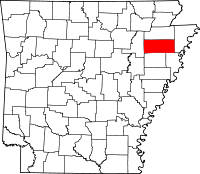Poinsett County, Arkansas
| Poinsett County, Arkansas | |
|---|---|

Poinsett County Courthouse, June 2011
|
|
 Location in the U.S. state of Arkansas |
|
 Arkansas's location in the U.S. |
|
| Founded | February 28, 1838 |
| Named for | Joel Roberts Poinsett |
| Seat | Harrisburg |
| Largest city | Trumann |
| Area | |
| • Total | 763 sq mi (1,976 km2) |
| • Land | 758 sq mi (1,963 km2) |
| • Water | 5.2 sq mi (13 km2), 0.7% |
| Population (est.) | |
| • (2015) | 24,040 |
| • Density | 32/sq mi (12/km²) |
| Congressional district | 1st |
| Time zone | Central: UTC-6/-5 |
| Website | www |
Poinsett County is a county located in the U.S. state of Arkansas. As of the 2010 census, the population was 24,583. The county seat is Harrisburg.
Poinsett County is included in the Jonesboro, AR Metropolitan Statistical Area.
Poinsett County was formed on February 28, 1838, and named for Joel Roberts Poinsett, U.S. Secretary of War. County business was initially conducted in the county judge's home until first court was held in Bolivar upon completion of a courthouse in 1839. County government was moved in 1859 to Harrisburg, a more central locale. Poinsett County acquired its current boundaries in the years following this move. The northern portion became Craighead County, the south portion became Cross County. Sunken lands were added to eastern Poinsett County during this time, including Lepanto and Marked Tree.
The Civil War devastated the county financially, and it wouldn't recover until the railroads gave farmers a new avenue to market their crops and the emergence of a timber industry. The Texas and St. Louis Railway Company completed track through Weiner and the St. Louis and Iron Mountain Railway ran through the center of the county in 1882, with the Kansas City, Ft. Scott, and Gulf Railroad opening service in east Poinsett County the following year. Shipping timber had become feasible and began throughout northeast Arkansas following the completion of railroads. Farmers were also able to bring their cotton and farm animals to new markets. Many small railroad towns boomed during this period. Despite this uplift, the county mostly consisted of poor sharecroppers and tenant farmers.
...
Wikipedia
